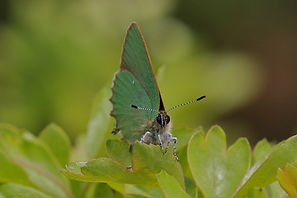
Hairstreaks (Lycaenidae)
A small group of dainty little butterflies which can be difficult to find. Very specialised in habitat needs. Most people will probably never see one, yet they are an exquisite group. They are part of the same family as the Blues and Coppers. Only the purple and brown open their wings when not in flight.
Black Hairstreak - A very rare butterfly that only occurs along a strip of the country between Peterborough and Oxford. Worse still they can only be seen within a couple of weeks, as they spend most of their time around tree tops. For a few days they come down and nectar on shrubs, usually bramble. If you get it right (keep an eye on Twitter) they couldn't be easier to see. They are sedentary and very approachable.


BCNWT - Glapthorn Cow Pastures - a classic site in Northants
Brown Hairstreak - Generally thought of as the hardest butterfly to find. They are also perhaps the last to emerge in the year. August into Sept. It was third year lucky for me, scouring a well known hotspot annually. Well worth it though. It's the females that are the prize in this species. As the one here.


Grafton Wood, Worcs
Green Hairstreak - Although this species is fairly widespread and probably not that rare, it can take some finding. It took me a long time to find my first. Like most things it's a matter of getting your eye in. Being green they definitely don't stand out when resting on small trees or shrubs, unless you see them fly. Again, well worth the effort though. They're stunning little creatures. Their upper wings are dull, chocolate brown, but you'll only see that in flight.


Ryton Wood Meadows, Warks

2&3 Whixall Moss, Shrops
Purple Hairstreak - You require an element of luck to see this species. Yet they are not at all rare. They live high up in oak trees. You can sometimes see them chasing each other around the tops of trees but if you're really lucky you might spot one near the ground nectaring. A lovely butterfly and one of the only two purple species we have.


Feeding on honeydew on oak leaves, where they spend most of their time. Baggeridge CP, Staffs.

White Letter Hairstreak - Another difficult species to find, though occasionally are seen in groups nectaring together. Usually in July. Easily missed due to their size and colour. Named after the large white W on the underwing. They don't open their wings when not flying. They are very similar to the Black Hairstreak, but lack the black spots on the inner edge of the orange stripe.

